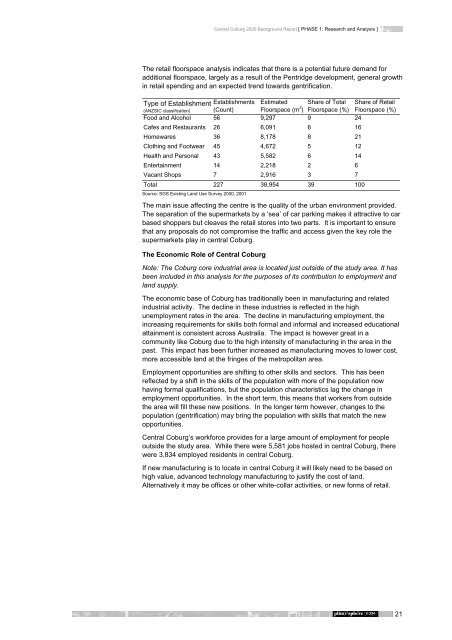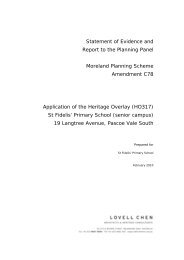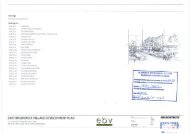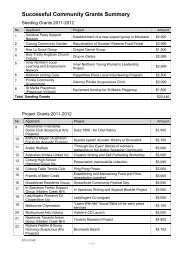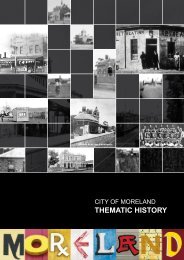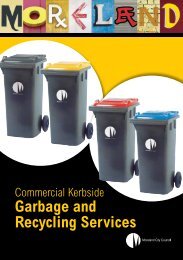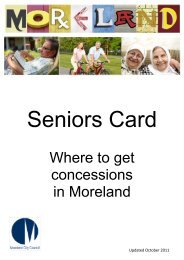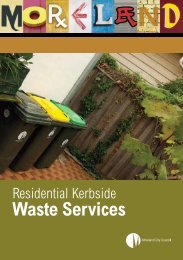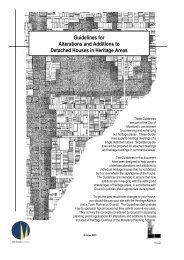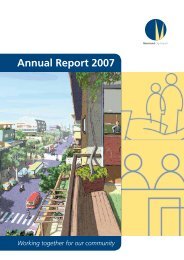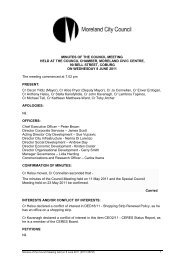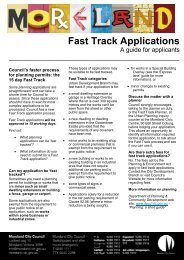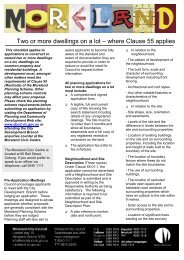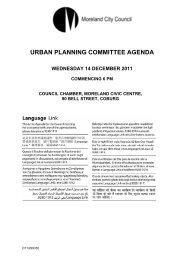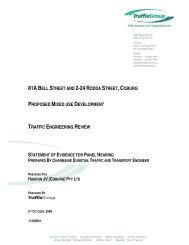Local Planning Policy Framework - Moreland City Council
Local Planning Policy Framework - Moreland City Council
Local Planning Policy Framework - Moreland City Council
You also want an ePaper? Increase the reach of your titles
YUMPU automatically turns print PDFs into web optimized ePapers that Google loves.
Central Coburg 2020 Background Report [ PHASE 1: Research and Analysis ]<br />
The retail floorspace analysis indicates that there is a potential future demand for<br />
additional floorspace, largely as a result of the Pentridge development, general growth<br />
in retail spending and an expected trend towards gentrification.<br />
Type of Establishment Establishments<br />
(ANZSIC classification) (Count)<br />
Estimated<br />
Floorspace (m 2 Share of Total<br />
) Floorspace (%)<br />
Share of Retail<br />
Floorspace (%)<br />
Food and Alcohol 56 9,297 9 24<br />
Cafes and Restaurants 26 6,091 6 16<br />
Homewares 36 8,178 8 21<br />
Clothing and Footwear 45 4,672 5 12<br />
Health and Personal 43 5,582 6 14<br />
Entertainment 14 2,218 2 6<br />
Vacant Shops 7 2,916 3 7<br />
Total 227 38,954 39 100<br />
Source: SGS Existing Land Use Survey 2000, 2001<br />
The main issue affecting the centre is the quality of the urban environment provided.<br />
The separation of the supermarkets by a ‘sea’ of car parking makes it attractive to car<br />
based shoppers but cleaves the retail stores into two parts. It is important to ensure<br />
that any proposals do not compromise the traffic and access given the key role the<br />
supermarkets play in central Coburg.<br />
The Economic Role of Central Coburg<br />
Note: The Coburg core industrial area is located just outside of the study area. It has<br />
been included in this analysis for the purposes of its contribution to employment and<br />
land supply.<br />
The economic base of Coburg has traditionally been in manufacturing and related<br />
industrial activity. The decline in these industries is reflected in the high<br />
unemployment rates in the area. The decline in manufacturing employment, the<br />
increasing requirements for skills both formal and informal and increased educational<br />
attainment is consistent across Australia. The impact is however great in a<br />
community like Coburg due to the high intensity of manufacturing in the area in the<br />
past. This impact has been further increased as manufacturing moves to lower cost,<br />
more accessible land at the fringes of the metropolitan area.<br />
Employment opportunities are shifting to other skills and sectors. This has been<br />
reflected by a shift in the skills of the population with more of the population now<br />
having formal qualifications, but the population characteristics lag the change in<br />
employment opportunities. In the short term, this means that workers from outside<br />
the area will fill these new positions. In the longer term however, changes to the<br />
population (gentrification) may bring the population with skills that match the new<br />
opportunities.<br />
Central Coburg’s workforce provides for a large amount of employment for people<br />
outside the study area. While there were 5,581 jobs hosted in central Coburg, there<br />
were 3,834 employed residents in central Coburg.<br />
If new manufacturing is to locate in central Coburg it will likely need to be based on<br />
high value, advanced technology manufacturing to justify the cost of land.<br />
Alternatively it may be offices or other white-collar activities, or new forms of retail.<br />
21


